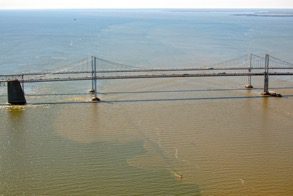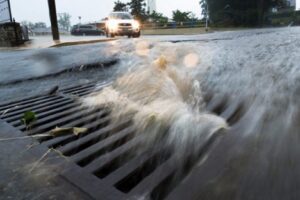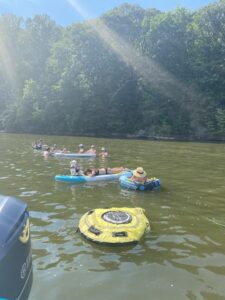Issue 8 | June 2023 | Dear Shark | OK to Swim in the Bay?

Dear Shark,
“It’s summertime, which means we will be doing lots of swimming and playing in the local rivers and the Chesapeake Bay – whether it’s an afternoon on a boat and floating around a sandbar, or just jumping off a dock to cool off on a hot day. However, I have heard that after a thunderstorm or extended rainfall, I should keep out of the water. Is this because the water runoff can create strong currents?”
Sincerely, Bay Swimmer
Answer provided by: Dr. Tammy Domanski, Director of Environmental Center and Biology Professor at Anne Arundel Community College
Dear Bay Swimmer,
Great question. Strong currents can be an issue in areas where narrow channels condense a deluge of water into a little space and make it move more quickly.  Currents can also be found after severe rain and flood events that can overtake roads and other places people regularly traverse. However, the concern to stay out of local waterways and the Bay after rain is different. The problem is the large quantities of harmful runoff that happen when a heavy thunderstorm dumps a half inch or more of rain in our region. Take a look at the EPA guidelines on runoff and how we can help.
Currents can also be found after severe rain and flood events that can overtake roads and other places people regularly traverse. However, the concern to stay out of local waterways and the Bay after rain is different. The problem is the large quantities of harmful runoff that happen when a heavy thunderstorm dumps a half inch or more of rain in our region. Take a look at the EPA guidelines on runoff and how we can help.
Our local rivers and the Chesapeake Bay are brimming with a wide variety of microorganisms. Many of these organisms are beneficial to the environment when their levels are not too high. Phytoplankton are essential primary producers, the basis of the food web, and feed Zooplankton, ‘tiny animals’, another level in the web. Many types of bacteria are natural inhabitants and are important decomposers, breaking complex substances down and taking dead plant material out of the water.
However, some microbes, including some bacteria, can be harmful to humans. In our area, the number of harmful bacteria tends to be low and usually won’t cause illness, especially if we’re healthy and don’t have open cuts when we’re swimming. Sometimes, most often due to stormwater runoff after a heavy rain, harmful bacteria that are normally found in the digestive systems of warm-blooded  mammals and some birds, are carried into our waterways. As rain accumulates on roads, driveways, parking lots, or runs quickly across lawns, which do not absorb heavy rain very well, water rushes toward low points directly into rivers and creeks in areas next to the shore or indirectly by flowing into storm drains. The label painted on many storm drains “Drains to Bay” indicates that whatever enters storm drains eventually makes its way to the Bay, usually by entering the nearest creek or stream through stormwater outfall pipes.
mammals and some birds, are carried into our waterways. As rain accumulates on roads, driveways, parking lots, or runs quickly across lawns, which do not absorb heavy rain very well, water rushes toward low points directly into rivers and creeks in areas next to the shore or indirectly by flowing into storm drains. The label painted on many storm drains “Drains to Bay” indicates that whatever enters storm drains eventually makes its way to the Bay, usually by entering the nearest creek or stream through stormwater outfall pipes.
You may have heard that it’s not recommended to swim for 48 hours after a rain event of at least one-half inch. That recommendation is based on observations that potentially harmful bacterial loads are high enough after rain of a half-inch or more to increase the risk of illness significantly in humans and our pets. When we swim, we may be exposed to harmful organisms if there are breaks in our skin or we swallow some water. Swallowing water can lead to a number of digestive issues including nausea and vomiting. Skin exposure can result in infections, rashes or eye and ear infections. Will everyone get sick if you have contact with the water after a heavy rain? No, but the risk is elevated in many locations.
There are tests to help track the risk and provide a snapshot of water quality in our waters. As mentioned above, the recommendation is to avoid swimming for 48 hours after a heavy rain, but is the risk the same everywhere? That’s where water testing can help. Collecting a sample of water at specific locations and comparing the concentration of bacteria in a specific amount of water to values provided by the Environmental Protection Agency can tell us when the risk of potential illness is higher than normal. During the summer season, when more people are in and on the water, you may see Anne Arundel Community College Environmental Center technicians collecting samples at a number of locations. Their efforts are funded by community organizations and individuals interested in monitoring the safety and water quality of our rivers and creeks. Individual measurements give a snapshot of water conditions, and tracking the data for an entire season provides a picture of the trends at each site. Monitoring is performed rain or shine, and informs communities not only about how swimmable the water is when the weather has been clear and sunny, but also how much bacteria make their way into the waters after a rain event.
Information is key to making informed decisions about time in the water. Knowing one’s health status, including susceptibility to infections and presence of open wounds, and knowing the potential risk of infection, in terms of the typical bacterial loads during good weather and after rain events, makes it possible for individuals and families to make wise choices about water recreation.  It’s always wise to rinse off with clean water and soap after swimming in our local rivers and creeks and keep cuts covered and treated with antibiotic creams. Also, it’s very important to understand that the bacterial levels reported by the Anne Arundel Community College Environmental Center and local health departments, report the values for one group of bacteria that are associated with contamination from humans, other warm-blooded animals and some birds. There are other types of potentially harmful bacteria that are naturally found in our waters, with concentrations varying depending on water temperature and salinity. At present, there are not specific numbers of these bacteria in the water that predict the risk for infection. However, some of the same considerations apply. Know your own health status, consider avoiding contact if you have open cuts and rinse off thoroughly after exposure.
It’s always wise to rinse off with clean water and soap after swimming in our local rivers and creeks and keep cuts covered and treated with antibiotic creams. Also, it’s very important to understand that the bacterial levels reported by the Anne Arundel Community College Environmental Center and local health departments, report the values for one group of bacteria that are associated with contamination from humans, other warm-blooded animals and some birds. There are other types of potentially harmful bacteria that are naturally found in our waters, with concentrations varying depending on water temperature and salinity. At present, there are not specific numbers of these bacteria in the water that predict the risk for infection. However, some of the same considerations apply. Know your own health status, consider avoiding contact if you have open cuts and rinse off thoroughly after exposure.
There are a number of resources that provide more information and data on our local rivers and creeks. Visit Operation Clearwater 2023 or email environmentalcenter@aacc.edu for more information.
Sincerely, Shark
Have a question…we have the answer! Send us an email on it and what you want to know more about?

